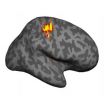(Press-News.org) New research has shown that certain Australian native flowers have shifted away from using insects as pollinators and evolved their flower colour to the red hues favoured by birds.
In a study published in New Phytologist, biologists from Monash University and RMIT University have shown for the first time that Australian native flowers exclusively pollinated by birds have evolved colour spectral signatures that are best discriminated by those birds.
Dr Adrian Dyer of Monash and RMIT said previous studies had shown that flower colour evolved to attract bees as pollinators.
"We know that some flowers had evolved spectral signatures to suit bee pollinators, but the story for bird-pollinated flowers was not clear," Dr Dyer said.
Lead author and PhD student Mani Shrestha of the Monash School of Biological Sciences collected spectral data from over 200 flowering plants and identified the pollinators as birds or insects. Then with Associate Professor Martin Burd - also of the School of Biological Sciences - did phylogenetic analyses to identify how the flowers have evolved spectral signatures.
"We found that flowers exclusively pollinated by birds had initially evolved to suit insect vision, but more recently the spectral signature of bird pollinated flowers had shifted towards longer wavelengths," Mr Shesthra said
The research showed that rather than just having any type of red reflection, bird pollinated flowers targeted the specific wavelengths that best match the long wavelength tetrachromatic (four colour) vision of many Australian native birds.
"Bird pollinated flowers may have evolved red signals to be inconspicuousness to some insects that are poor pollinators, whilst also enhancing the discrimination of bird pollinators," Mr Shresthra said.
Associate Professor Burd said the work had broad significance for understanding how flower colours have evolved to suit specific pollinators, and how colour may continue to evolve in particular environments depending upon the availability of effective pollinators.
"The colour cues in Australian flowers would be easily detected by honeyeaters, the most important family of nectar feeding birds in Australia. Hummingbirds in the Americas have similar visual systems to honeyeaters, so we expect to find similar colour signals among American flowers," Associate Professor Burd said.
"But in Asia and Africa, birds with a different type of colour vision are the primary avian pollinators. If flower colours in these regions are tuned to the specific capacities of their own birds, we would have strong evidence that we've cracked the code that plants use to communicate with birds."
### END
For birds, red means 'go'
2013-03-05
ELSE PRESS RELEASES FROM THIS DATE:
Genetics Society of America's Genetics journal highlights for March 2013
2013-03-05
Bethesda, MD—March 5, 2013 – Listed below are the selected highlights for the March 2013 issue of the Genetics Society of America's journal, Genetics. The March issue is available online at www.genetics.org/content/current. Please credit Genetics, Vol. 193, MARCH 2013, Copyright © 2013.
Please feel free to forward to colleagues who may be interested in these articles on cellular genetics; population and evolutionary genetics; genome integrity and transmission; and genome and systems biology.
ISSUE HIGHLIGHTS
Cellular Genetics:
Systems genetics implicates cytoskeletal ...
New gene variant may explain psychotic features in bipolar disorder
2013-03-05
Researchers at Karolinska Institutet in Sweden have found an explanation for why the level of kynurenic acid (KYNA) is higher in the brains of people with schizophrenia or bipolar disease with psychosis. The study, which is published in the scientific periodical Molecular Psychiatry, identifies a gene variant associated with an increased production of KYNA. The discovery contributes to the further understanding of the link between inflammation and psychosis – and might pave the way for improved therapies.
Kynurenic acid (KYNA) is a substance that affects several signalling ...
Discovery of human genetic mutation could lead to new treatments for type 1 diabetes
2013-03-05
In type 1 diabetes, the immune system destroys insulin-producing cells in the pancreas, but the precise cause has not been clear. A study published by Cell Press on March 5th in Cell Metabolism reveals that a single mutation in the "longevity gene" SIRT1 can cause type 1 diabetes in humans. The findings unearth the role this gene plays in human autoimmunity and disease and also offer new avenues for treating a range of autoimmune disorders.
"We describe one of the first single gene defects leading to type 1 diabetes, as well as the first human mutation in the SIRT1 gene," ...
Molecular coordination in evolution: A review in 'Nature Reviews Genetics'
2013-03-05
Spanish National Cancer Research Centre (CNIO) researchers Alfonso Valencia, Director of the Structural Biology and Biocomputing Programme and David de Juan, jointly with Florencio Pazos, from the Spanish National Centre for Biotechnology (CNB-CSIC), publish a review on the latest computational methods that, based on evolutionary principles, are revolutionising the field of analysis and prediction of protein structure, function and protein-protein interactions, as well as the short- and long-term expectations for the field.
"The computational and mathematical analysis ...
How cells optimize the functioning of their power plants
2013-03-05
Mitochondria, which are probably derived from distant bacterial ancestors incorporated into our cells, have their own DNA. However, we know little about how these organelles, which convert oxygen and consumed nutrients into energy, regulate the expression of their own genes. Jean-Claude Martinou, professor at the University of Geneva (UNIGE), Switzerland, and his team, have discovered the existence of compartments at the heart of mitochondria, consisting of hundreds of different proteins. It is here that RNA molecules (the many copies made from DNA) come together to be ...
Single gene might explain dramatic differences among people with schizophrenia
2013-03-05
March 5, 2013 (Toronto) – Some of the dramatic differences seen among patients with schizophrenia may be explained by a single gene that regulates a group of other schizophrenia risk genes. These findings appear in a new imaging-genetics study from the Centre for Addiction and Mental Health (CAMH).
The study revealed that people with schizophrenia who had a particular version of the microRNA-137 gene (or MIR137), tended to develop the illness at a younger age and had distinct brain features – both associated with poorer outcomes – compared to patients who did not have ...
Viruses: More survival tricks than previously thought
2013-03-05
Among eukaryotes with modified nuclear genetic codes, viruses are unknown. Until now it had been believed that the modifications to the genetic code effectively prevented new viral infections. However, researchers have now reported the first example of a virus that can be shown to have crossed the boundary from organisms using the standard genetic code to those with an alternate genetic code.
"The finding is significant because it means that virus-host co-evolution after a genetic code shift can be more extensive than previously thought", said researcher Derek J. Taylor, ...
West Nile virus passes from female to eggs, but less so from larvae to adults
2013-03-05
In California Culex mosquitoes are considered to be the principle vectors of West Nile virus (WNV), which infects birds, humans, and other mammals during the summer. In addition, these mosquitoes may also serve as overwintering reservoir hosts as the virus is passed "vertically" from female mosquito to egg, then larva, and then adult.
To find out how often this happens, California researchers monitored WNV in mosquitoes in the field and in the lab, and observed how the virus is transmitted between generations and between insect stages. The results are published in the ...
Remains of extinct giant camel discovered in High Arctic by Canadian Museum of Nature
2013-03-05
Ottawa, Canada, March 5, 2013 - A research team led by the Canadian Museum of Nature has identified the first evidence for an extinct giant camel in Canada's High Arctic. The discovery is based on 30 fossil fragments of a leg bone found on Ellesmere Island, Nunavut and represents the most northerly record for early camels, whose ancestors are known to have originated in North America some 45 million years ago.
The fossils were collected over three summer field seasons (2006, 2008 and 2010) and are about three-and-a-half million years old, dating from the mid-Pliocene ...
Amputee phantom pain linked to brain retaining picture of missing limb
2013-03-05
Changes in the brain following amputation have been linked to pain arising from the missing limb, called 'phantom pain', in an Oxford University brain imaging study.
Arm amputees experiencing the most phantom limb pain were found to maintain stronger representation of the missing hand in the brain – to the point where it was indistinguishable from people with both hands.
The researchers hope their identification of brain responses correlated with the level of phantom pain can aid the development of treatment approaches, as well as increase understanding of how the brain ...


